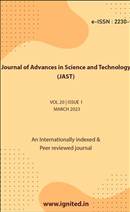Experimental Study on Properties of Pervious Concrete Pavement Material and its Implementation in Heavy Traffic Area at Mumbai
DOI:
https://doi.org/10.29070/jcbhf173Keywords:
pervious concrete, pavement material, properties, implementation, heavy traffic area, Mumbai, water absorption, soil water content, surface runoff, water table, rainwater harvesting, durabilityAbstract
Pervious concrete is the construction material that has pores that can be penetrate by water.Due to voids present in concrete it used to absorb runoff from the surface and simultaneously increasesoil water content. With applied to pavement or low traffic road like open parking areas in city, waterrunoff from the surface is expected to absorb into the soil and can be reduced clearance of waterdischarging into drainage channel or allow to percolate into the soil for the purpose of increase watertable. Porous concrete pavements are more suitable than other conventional concrete especially inparking lots, sidewalks and driveways to control surface runoff. It also requires low cost as compare toconventional concrete and also properly manage rainwater harvesting. then Utilization of that modifyconcrete on actual site in Mumbai region study the durabilityDownloads
References
Alessandra Bonicelli, Gilberto Martinez Arguelles, Luis Guillermo Fuentes Pumarejo “Improving Pervious Concrete Pavements for Achieving More Sustainable Urban Roads” (2016).
AASHTO (American Association of State Highway and Transportation Officials). 1993. “Guide for Design of Pavement Structures”, AASHTO, Washington, D.C., USA.
ACPA (American Concrete Paving Association). “Storm water management with pervious concrete pavement”. ACPA, Skokie, IL, USA (2009).
BeeldensA. Herrier G., 2006. “Water pervious pavement blocks: the belgian experience”, 8th International conference on Block Paving materials.
Benjamin O. Brattebo and Derek B. Booth,2003. “Long-term Storm water Quantity and Quality Performance of Permeable Pavement Systems,” Water Research.
Craig Tosomeen P.E city of Olympia, Washington “Low development storm water conference November 2008” (July 2008).
Chai, L., Kayhanian, M., Givens, B., Harvey, J.T., and Jones, D. 2012. "Hydraulic performance of fully permeable highway shoulder for storm water runoff management." Journal of Environmetal Engineering,
Chopra, M., Kakuturu, S., Ballock, C., Spence, J., and Wanielista, M. 2010. "Effect of Rejuvenation Methods on the Infiltration Rates of Pervious Concrete Pavements. "Journal of Hydrologic Engineering,
David K. Hein, Eric Strecker, P.E., Aaron Poresky, P.E. and Dr. Robert Roseen ‘‘Permeable Shoulders with Stone Reservoirs’’ -American Association of State Highway and Transportation Officials. (AASHTO) (October 4, 2013).
Henderson 2011. Henderson V., Tighe, S.L., Evaluation of Pervious Concrete, Pavement Maintenance Methods at Field Sites in Canada, Transportation Research Board, 2011 Annual Meeting.
Interlocking Concrete Pavement Institute (ICPI). (2004). Tech Spec 8, Concrete Grid Pavements. Washington, D.C.: ICPI.
Rishi Gupta “Monitoring in situ performance of pervious concrete in British Columbia- A pilot study” October 2013.






